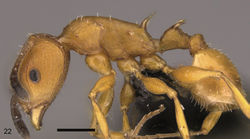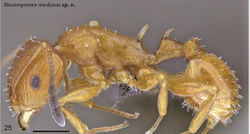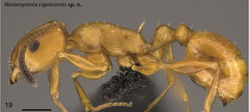Key to Nesomyrmex hafahafa group
This worker key is based on: Csösz, S. and Fisher, B.L. 2015. Diagnostic survey of Malagasy Nesomyrmex species-groups and revision of hafahafa group species via morphology based cluster delimitation protocol. ZooKeys. 526:19-59.
The species of the Nesomyrmex hafahafa group differ in body ratios. The following dichotomous identification key for the worker caste was generated based on ratios of morphological features that allow quick identification. Minimum and maximum values for each character is given in parentheses. The reliability of all characters has been tested and calculated classification success was always higher than 95% for each node. Where classification error was detected (i.e. the range of a given trait overlaps between two species) a percentile range 5–95% was also provided in brackets.
You may also be interested in
- Nesomyrmex
- Key to Nesomyrmex species groups of the Malagasy region
- Diagnosis of Nesomyrmex species groups of the Afrotropical and Malagasy regions
1
- Propodeal spine very short (Fig. 15). Spine length vs. absolute cephalic size (SPST/CS): ≤ 0.330 (min. 0.258, max. 0.330) . . . . . Nesomyrmex spinosus
- Propodeal spine longer (Figs 16–18). Spine length vs. absolute cephalic size (SPST/CS): > 0.330 (min. 0.333, max. 0.437) . . . . . 2
2
return to couplet #1
- Bases of anterodorsal petiolar spines enclose a triangular truncate area on the dorsum of petiolar node delineated by a rim (Fig. 16). In dorsal view, anterodorsal petiolar spines distantly surpassing lateral margin of petiole (Fig. 16). Apical distance of the anterodorsal spines on the petiolar node vs. petiole width (NSTI/PEW): > 1.550 (min. 1.531, max. 1.948), [5–95% percentiles: min. 1.563, max. 1.873] . . . . . Nesomyrmex hafahafa
- There is no conspicuous truncate area on the dorsum of petiolar node (Figs 17–18). Apical distance of the anterodorsal spines on the petiolar node vs. petiole width (NSTI/PEW): < 1.550 (min. 0.795, max. 1.575), [5–95% percentiles: min. 0.823, max. 1.549] . . . . . 3
3
return to couplet #2
- In dorsal view, distance between tips of anterodorsal petiolar spines longer than petiole width, spines surpassing lateral margins of petiole (Fig. 17). Apical distance of the anterodorsal spines on the petiolar node vs. petiole width (NSTI/PEW): > 1.090 (min. 1.055, max. 1.575), [5–95% percentiles: min. 1.094, max. 1.549]. Pronotal spines wider; apical distance of pronotal spines vs. absolute cephalic size (PSTI/CS): > 0.700 (min. 0.711, max. 0.813) . . . . . Nesomyrmex medusa
- In dorsal view, distance between tips of anterodorsal petiolar spines shorter than petiole width (Fig. 18). Apical distance of the anterodorsal spines on the petiolar node vs. petiole width (NSTI/PEW): > 1.090 (min. 0.795, max. 1.220), [5–95% percentiles: min. 0.823, max. 1.083]. Apical distance of pronotal spines vs. absolute cephalic size (PSTI/CS): < 0.700 (min. 0.617, max. 0.690) . . . . . Nesomyrmex capricornis








